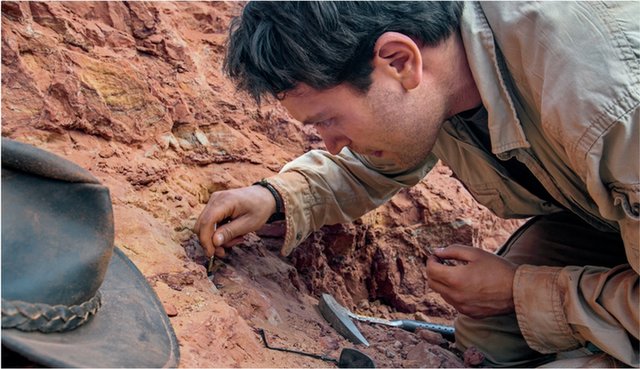
Ibrahimworksslowlyand carefully.
OntheTrail
Itwascrazy.Ibrahimknewthat.Fiveyearshadpassed.Hedidn’tknowthefossilhunter’snameoraddress.Allheknewwasthatthemanhadamustache.Thatwasn’tmuchtogoon.Still,Ibrahimwouldn’tletgooftheidea.Ifhecouldfindthefossilhunteragain,maybehecouldfind Spinosaurus.
IbrahimtraveledbacktothesmalltowninMoroccoand,againstallodds,beganhissearch.Dayswentbywithoutsuccess.Nooneseemedtoknowwhoorwherethefossilhunter was.
Timewasrunningout.Ibrahim’sspiritssank.Thetaskseemedimpossible.OnhislastdayinMorocco,Ibrahimsatwith twofriendsinasmallcafé,sippingtea.Hecouldfeelhisdreamslipping away.
Thensuddenly,helookedup.Atallman,wearingwhite,passedbyhistable.Themanlookedfamiliar,andhehada mustache.
Ibrahimleapedupandchasedafterhim.Ibrahim’sheartbeatwildly.Hecaughtuptothemanandlookedathisface.Itwasthefossilhunter!Now,ifonlythefossilhunterwouldleadhimtothe fossils.
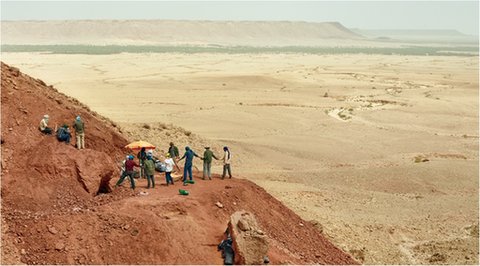
IbrahimwasledintothedeserttofindSpinosaurus.
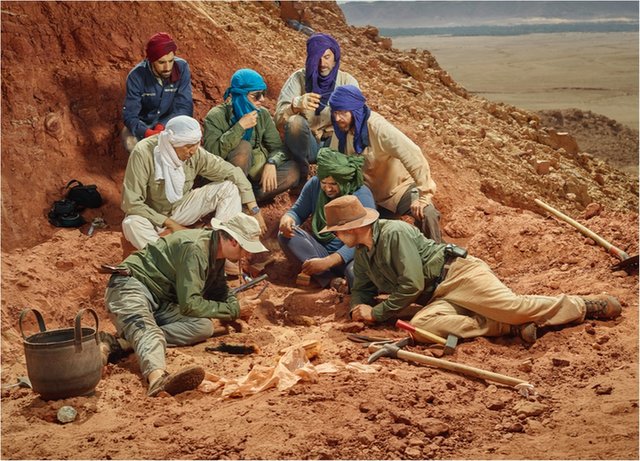
IbrahimworkedwithateamtouncoverSpinosaurusbones.
Discovery!
ThemanwiththemustachelistenedcloselytoIbrahim.HeunderstoodwhatIbrahimwastryingtodoandhowimportantitwas.HeagreedtoleadIbrahimtotheplacewherehehadfoundthe fossils.
Thenextday,thetwomendroveashortdistanceintotheSahara.Thenthefossilhunterstoppedtheirvehicle.Theywouldhavetomaketherestofthetriponfoot.Theyclimbedasteepslopethatcouldn’tbeseenfromthemainroad.Nearthetop,theyreachedwhatlookedlikeasmallcavecarvedintothehillside.Thiswaswherethefossilhunterhadbeen digging.
Trembling,Ibrahimclimbedintothehole.Hetookadeepbreath.Usingspecialtools,hegentlypickedawayatsomeofthesandandrock.Withinminutes,hediscoveredseveralbones.Ibrahimstudiedthebonesandsmiled.Atlast,hehadfound Spinosaurus!
BuildingtheBeast
Ibrahim’ssearchforSpinosauruswasover,buthisworkonthehillsidewasjustbeginning.Manylarge,predatorydinosaursseemedtohavelivedinthisareaatthesametime.Didthatmeantheywerecompetingforthesameprey?IbrahimbegantoformahypothesisforhowSpinosauruscouldhavelivedamongotherbigpredators.Toprovehistheory,though,hehadtoconductanexperiment.IbrahimhadtorecreateSpinosaurus.
First,hetookallthefossilshe’dgatheredandputthemtogethertoseewhatthisdinosaurmighthavelookedlike.Hedidn’thaveallthepieces,buthehadenoughtogetstarted.Hismethodwastocreateadigitalmodelonacomputerbasedonwhatheknewso far.
Then,workingwithotherscientists,hemadeaskinforhismodelskeleton.NowhehadacompleteSpinosaurus.Whathehadcreatedsurprisedhim.Itlookedverydifferentfromalltheotherdinosaurshehadever seen.
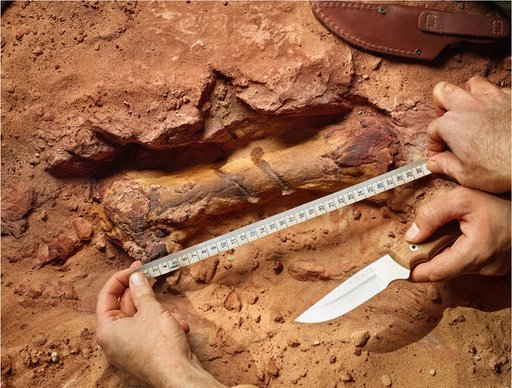
ThisSpinosaurusfootbonewasfoundatthedig site.
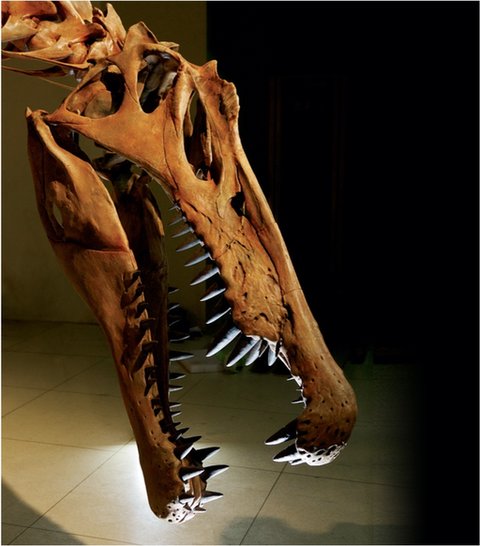
Spinosaurus’headwaslongand thin.
UntilIbrahimhadcreatedthismodel,scientistshadassumedthatSpinosaurusspentmostofitstimeonland.SeeingthewaythisdinosauractuallylookedmadeIbrahimrealizethatitprobablydidn’tspendmuchtime there.
Ibrahimmadeaconclusionthatthisdinosaurspentmostofitstimeinwater.Itslongtailmayhavehelpedpropelitthroughthewater.Spinosaurusprobablyhadwebbedfeetthatitusedtopaddlethroughwater.Highnostrilsallowedittokeepmostofitsheadunderwaterwhileithunted.ThisiswhySpinosauruscouldexistwiththeothermeat-eatingdinosaurs.Ithuntedinthe water.
MakingaModel
TheSpinosaurus’neckandbodywerelongerthanotherdinosaurs’.TheSpinosaurushadshorthindlegsandpowerfulforearms.Itsbackfeetwerewideandflat.ToIbrahim,theylooked
like paddles.
IbrahimstudiedSpinosaurus’skullclosely.Ithadalongsnout,butitsnostrilswerehalfwayuptheskull.Andthentherewasthesail.Itwasabout1.8meters(5.9feet)longandrosemorethan1.8meters
(5.9feet)fromits back.

Spinosaurus’wide,backfeetmayhavebeenwebbed,whichwouldhavehelpedit swim.